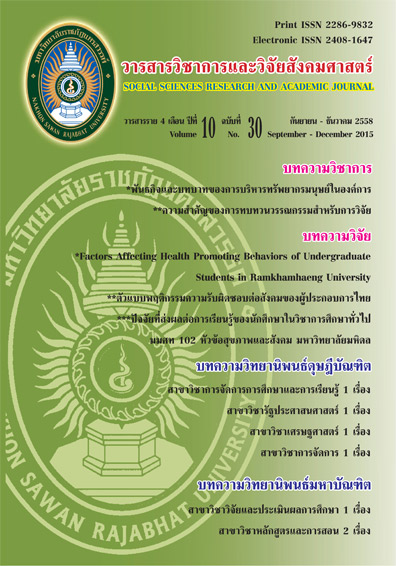การพัฒนาตัวชี้วัดการเรียนรู้ด้วยตนเองของนิสิตระดับปริญญาตรี; The Development of Self-directed Learning Indicators of Undergraduate Students
Main Article Content
Abstract
บทคัดย่อ
การวิจัยในครั้งนี้มีวัตถุประสงค์เพื่อพัฒนาตัวชี้วัดการเรียนรู้ด้วยตนเองของนิสิตระดับปริญญาตรี ผู้ให้ข้อมูลในการพัฒนาตัวชี้วัดเป็นผู้เชี่ยวชาญซึ่งเป็นอาจารย์ของสถาบันอุดมศึกษา จำนวน 9 ท่าน จำแนกเป็น 2 กลุ่ม ได้แก่ ผู้เชี่ยวชาญในด้านการเรียนรู้ด้วยตนเอง จำนวน 7 ท่าน และผู้เชี่ยวชาญที่เป็นผู้บริหารจัดการหลักสูตรระดับปริญญาตรีขึ้นไป จำนวน 2 ท่าน กลุ่มตัวอย่าง ได้แก่ นิสิต/นักศึกษาระดับปริญญาตรี ชั้นปี 2-4 ในสถาบันอุดมศึกษาในประเทศไทย 4 ภูมิภาค จำนวน 7 สถาบัน รวม 473 คน ได้จากการสุ่มแบบหลายขั้นตอน วิเคราะห์ข้อมูลโดยใช้เทคนิคการวิเคราะห์องค์ประกอบเชิงยืนยันอันดับที่สอง ด้วยโปรแกรมลิสเรล
ผลการวิจัยพบว่า
ขั้นตอนที่ 1 การพัฒนาองค์ประกอบและตัวชี้วัดการเรียนรู้ด้วยตนเองของนิสิตระดับปริญญาตรี พบว่า องค์ประกอบและตัวชี้วัดการเรียนรู้ด้วยตนเองของนิสิตระดับปริญญาตรี มี 4 องค์ประกอบ 13 ตัวชี้วัด ได้แก่ องค์ประกอบด้านการเตรียมการในการเรียนรู้ด้วยตนเอง คุณลักษณะของผู้เรียนในการเรียนรู้ด้วยตนเอง กระบวนการเรียนรู้ด้วยตนเอง และการประเมินผลการเรียนรู้ด้วยตนเอง
ขั้นตอนที่ 2 การตรวจสอบความตรงเชิงโครงสร้างขององค์ประกอบและตัวชี้วัดการเรียนรู้ด้วยตนเองของนิสิตระดับชั้นปริญญาตรีโดยใช้โมเดลการวิเคราะห์องค์ประกอบเชิงยืนยันอันดับที่สอง พบว่า ค่าน้ำหนักองค์ประกอบ (Factors Loading) ของตัวชี้วัดการเรียนรู้ด้วยตนเองของนิสิตระดับชั้นปริญญาตรี มีค่าอยู่ระหว่าง 0.48 – 0.66 และมีนัยสำคัญทางสถิติที่ระดับ .05 ทุกตัวชี้วัด แสดงว่า องค์ประกอบและตัวชี้วัดการเรียนรู้ด้วยตนเองของนิสิตระดับชั้นปริญญาตรีมีความตรงเชิงโครงสร้าง
Abstract
The purpose of this research was to develop self-directed learning indicators of undergraduate students. The self-directed indicators data were to be obtained from 9 higher education instructors. The 9 instructors have been separated into 2 groups including 7 self-directed experts and 2 undergraduate curriculum management administration experts. The samples were 473 undergraduate students who are studying in the second to fourth year in 4 regions, 7 universities in Thailand. The samples were received from Multi-stage Random Sampling. The second confirmatory factor analysis method by LISREL program was used for data analysis.
The results showed that:
1st step: The Development of self-directed learning factors and indicators for undergraduate students showed that self-directed learning factors and indicators for undergraduate students consist of 4 factors and 13 indicators, which are: the element of preparation for self-study, characteristic of the self-directed learning students, self-directed learning process, and self-evaluation.
2nd step: Inspecting construct validity of self-directed learning factors and indicators for undergraduate students by using the second confirmatory analysis method showed that the factors loading of self-directed learning factors and indicators for undergraduate students has value around 0.48 – 0.66 and has statistically significant difference at the .05 level for every indicator. This shows that self-directed learning factors and indicators for undergraduate students has construct validity.


